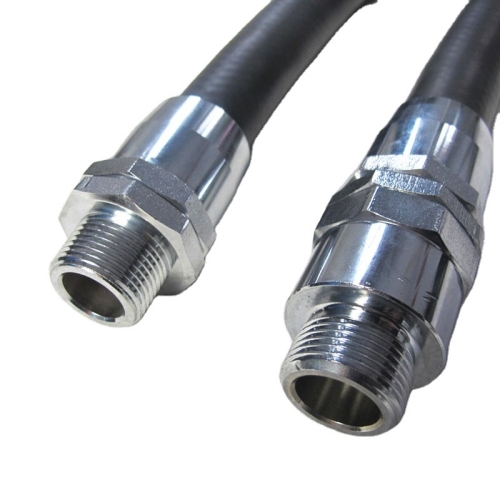335345435
Dec . 05, 2024 15:16 Back to list
double fiber braid hydraulic hose factory
The Double Fiber Braid Hydraulic Hose A Revolution in Hydraulic Engineering
In the world of hydraulic engineering, the significance of high-quality hoses cannot be overstated. Among the various types of hoses available, the double fiber braid hydraulic hose stands out due to its superior strength, durability, and flexibility. This article explores the manufacturing process of double fiber braid hydraulic hoses, their advantages, and their applications, illustrating why they are a favorite in various industries.
Understanding Double Fiber Braid Hydraulic Hoses
Double fiber braid hydraulic hoses are engineered to withstand high pressure and extreme conditions. These hoses are constructed with two layers of braided fiber reinforcement, which provides enhanced tensile strength and resistance to abrasion. The inner layer is usually made of high-quality synthetic rubber, which serves as the core, while the outer layer consists of tightly woven fibers that offer additional protection and support.
Manufacturing Process
The production of double fiber braid hydraulic hoses occurs in a meticulously controlled environment to ensure the highest standards of quality. The manufacturing process typically includes the following steps
1. Material Selection High-quality synthetic rubber is selected for the inner core, while durable fiber materials like polyester or nylon are chosen for the braided layers. These materials are vital for the hose’s performance and longevity.
2. Core Extrusion The synthetic rubber is extruded to form the inner core of the hose. This core is responsible for carrying the hydraulic fluid, emphasizing the importance of its integrity and resilience.
3. Fiber Braiding Once the core is shaped, the first layer of fiber is braided around it. This step is crucial, as the braiding technique significantly enhances the hose's strength. The fibers are interwoven in a specific pattern, ensuring optimal load distribution.
4. Second Layer Braiding After the initial braiding, a second layer of fiber is added. This two-layer braiding technique is what distinguishes this type of hose from single braid options. The additional layer increases the hose's resistance to bursting and provides enhanced stability, crucial for high-pressure applications.
5. Covering Finally, the outer layer of rubber is applied to protect against environmental factors such as UV rays, ozone exposure, and abrasion. This protective cover adds another level of durability, allowing the hose to withstand the rigors of industrial environments.
6. Quality Testing Before they are marketed, double fiber braid hydraulic hoses undergo rigorous testing for leaks, pressure resistance, and overall durability. This quality assurance phase is essential to ensure that each hose meets industry standards.
Advantages of Double Fiber Braid Hydraulic Hoses
double fiber braid hydraulic hose factory

The advantages of double fiber braid hydraulic hoses are numerous
- High Strength and Flexibility The unique braided design allows for a high degree of flexibility while maintaining strength under pressure. This combination makes them suitable for various applications where movement and pressure vary.
- Abrasion Resistance The outer layer provides excellent resistance to abrasion, extending the life of the hose and reducing maintenance costs for end-users.
- Temperature Resilience These hoses can withstand various temperatures, suitable for high-heat environments often seen in industrial applications.
- Reduced Risk of Bursting The double braiding significantly reduces the risk of hose failure during operation, making them a safer choice in high-pressure applications.
Applications
Double fiber braid hydraulic hoses are widely utilized in various industries, including
- Construction They are essential in excavators, bulldozers, and other heavy machinery where hydraulic power is crucial.
- Agriculture Used in agricultural machinery to ensure the efficient operation of hydraulic systems in tractors and harvesters.
- Automotive Employed in hydraulic brake systems, power steering systems, and other functions requiring reliable fluid transfer.
- Manufacturing Integrated into various machinery that relies on hydraulic power for operations such as stamping, molding, and lifting.
Conclusion
The double fiber braid hydraulic hose represents a significant advancement in hydraulic technology. With its durable design, flexibility, and high resistance to pressure, it meets the demands of various challenging environments. By ensuring quality during manufacturing and testing, factories can provide products that enhance safety and efficiency in hydraulic applications, ultimately leading to increased productivity across industries. As technology advances, we can expect further innovations in hose manufacturing, paving the way for even more robust and reliable hydraulic systems.
-
SAE 100 R17 Black Smooth Cover Hydraulic Hose
NewsMar.07,2025
-
SAE 100 R17 Black Smooth Cover Hydraulic Hose
NewsMar.07,2025
-
SAE 100 R17 Black Smooth Cover Hydraulic Hose
NewsMar.07,2025
-
SAE 100 R17 Black Smooth Cover Hydraulic Hose
NewsMar.07,2025
-
SAE 100 R17 Black Smooth Cover Hydraulic Hose
NewsMar.07,2025
-
steel wire braided hydraulic hose
NewsMar.07,2025



